World Atlas: Chad. On this page you can see the map, country flag and many detailed information about the people, history and economy of Chad.

Here you can find online selected information about the geography, inhabitants, government, economy and history of Chad. Included are selected statistics, an overview map and the detailed map of Chad. But let's start with the flag of Chad here:
Chad - Overview:
What you should know about Chad? Let's start with this: Chad, part of France's African holdings until 1960, endured three decades of civil warfare, as well as invasions by Libya, before peace was restored in 1990. The government eventually drafted a democratic constitution and held flawed presidential elections in 1996 and 2001. In 1998, a rebellion broke out in northern Chad, which has sporadically flared up despite several peace agreements between the government and insurgents. In June 2005, President Idriss DEBY held a referendum successfully removing constitutional term limits and won another controversial election in 2006. Sporadic rebel campaigns continued throughout 2006 and 2007. The capital experienced a significant insurrection in early 2008, but has had no significant rebel threats since then, in part due to Chad's 2010 rapprochement with Sudan, which previously used Chadian rebels as proxies. In late 2015, the government imposed a state of emergency in the Lake Chad region following multiple attacks by the terrorist group Boko Haram throughout the year; Boko Haram also launched several bombings in N'Djamena in mid-2015. DEBY in 2016 was reelected to his fifth term in an election that was peaceful but flawed. In December 2015, Chad completed a two-year rotation on the UN Security Council. In January 2017, DEBY completed a one-year term as President of the African Union.
Geography of Chad
 Where on the globe is Chad? The location of this country is Central Africa, south of Libya. Total area of Chad is 1.284 million sq km, of which 1,259,200 sq km is land. So this is very large country. How could we describe the terrain of the country? This way: broad, arid plains in center, desert in north, mountains in northwest, lowlands in south. The lowest point of Chad is Djourab 160 m, the highest point Emi Koussi 3,445 m. And the climate is tropical in south, desert in north.
Where on the globe is Chad? The location of this country is Central Africa, south of Libya. Total area of Chad is 1.284 million sq km, of which 1,259,200 sq km is land. So this is very large country. How could we describe the terrain of the country? This way: broad, arid plains in center, desert in north, mountains in northwest, lowlands in south. The lowest point of Chad is Djourab 160 m, the highest point Emi Koussi 3,445 m. And the climate is tropical in south, desert in north.
Inhabitants of Chad
Let's take a look how many people live in Chad. The number is: 12,075,985 (July 2017 est.). So this is not very populous country. Who lives here? Sara (Ngambaye/Sara/Madjingaye/Mbaye) 30.5%, Kanembu/Bornu/Buduma 9.8%, Arab 9.7%, Wadai/Maba/Masalit/Mimi 7%, Gorane 5.8%, Masa/Musseye/Musgum 4.9%, Bulala/Medogo/Kuka 3.7%, Marba/Lele/Mesme 3.5%, Mundang 2.7%, Bidiyo/Migaama/Kenga/Dangleat 2.5%, Dadjo/Kibet/Muro 2.4%, Tupuri/Kera 2%, Gabri/Kabalaye/Nanchere/Somrai 2%, Fulani/Fulbe/Bodore 1.8%, Karo/Zime/Peve 1.3%, Baguirmi/Barma 1.2%, Zaghawa/Bideyat/Kobe 1.1%, Tama/Assongori/Mararit 1.1%, Mesmedje/Massalat/Kadjakse 0.8%, other Chadian ethnicities 3.4%, Chadians of foreign ethnicities 0.9%, foreign nationals 0.3%, unspecified 1.7% (2014-15 est.). What are the languages in Chad? French (official), Arabic (official), Sara (in south), more than 120 different languages and dialects. And the religions: Muslim 52.1%, Protestant 23.9%, Roman Catholic 20%, animist 0.3%, other Christian 0.2%, none 2.8%, unspecified 0.7% (2014-15 est.). How old are the people in average? 17.8 years. We have to add that this number is the median - so one half of the people is older than this, one half is younger. And what is their life expectancy (at birth)? This: 50.6 years. Where the people live in Chad? Here: the population is unevenly distributed due to contrasts in climate and physical geography; the highest density is found in the southwest, particularly around Lake Chad and points south; the dry Saharan zone to the north is the least densely populated. The major urban areas of Chad are: N'Djamena (capital) 1.26 million (2015).
Government and Economy of Chad
The capital of Chad is N'Djamena and the government type presidential republic. Let's take a look at the administrative divisions - 23 regions (regions, singular - region); Barh el Gazel, Batha, Borkou, Chari-Baguirmi, Ennedi-Est, Ennedi-Ouest, Guera, Hadjer-Lamis, Kanem, Lac, Logone Occidental, Logone Oriental, Mandoul, Mayo-Kebbi Est, Mayo-Kebbi Ouest, Moyen-Chari, Ouaddai, Salamat, Sila, Tandjile, Tibesti, Ville de N'Djamena, Wadi Fira. Regarding the economy of Chad, important industrial products are oil, cotton textiles, brewing, natron (sodium carbonate), soap, cigarettes, construction materials. Important agricultural products are cotton, sorghum, millet, peanuts, sesame, corn, rice, potatoes, onions, cassava (manioc, tapioca), cattle, sheep, goats, camels. The most important export commodities are oil, livestock, cotton, sesame, gum arabic, shea butte and the most important export partners are US 57%, India 8.9%, China 6.7%, France 6.4%, UAE 4.3%, Japan 4.1% (2016). The most important import commodities are machinery and transportation equipment, industrial goods, foodstuffs, textiles and the most important import partners are France 19.8%, China 15.7%, Cameroon 15.1%, India 6.1%, US 5.4%, Belgium 4.4% (2016). How rich is Chad and how rich are people in this country? The most important number here is GDP per capita (PPP): $2,400 (2017 est.). This is a very low number. Let's add that this means Gross Domestic Product per person, which is recalculated with respect to the relative cost of local goods and services. And one more important number - population below poverty line: 46.7% (2011 est.).